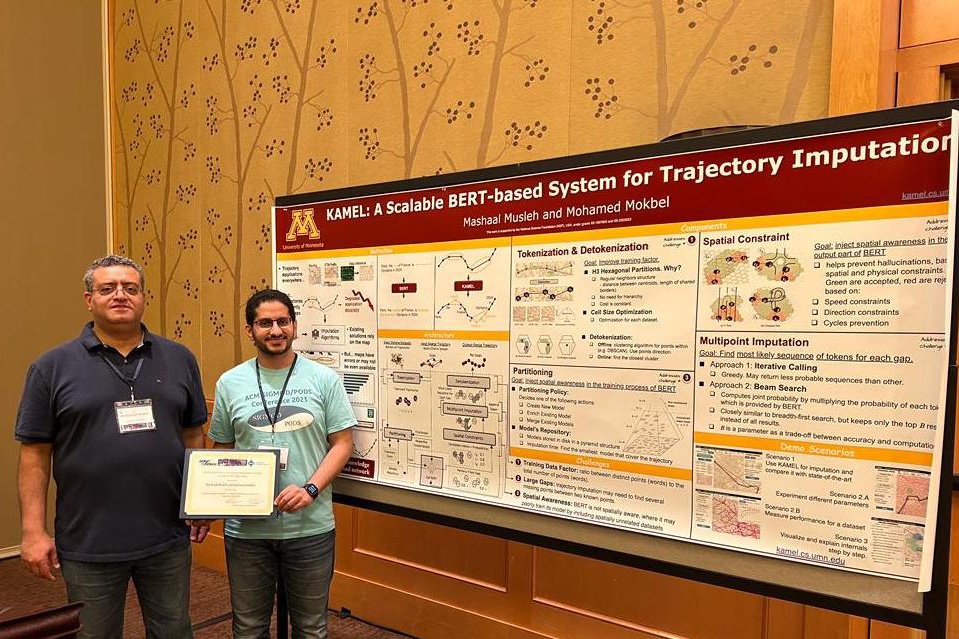Mashaal Musleh Wins Best Demo Award at 2023 ACM-SIGMOD

Department of Computer Science & Engineering (CS&E) Ph.D. candidate Mashaal Musleh earned the Best Demo Award at the Association for Computation Machinery Special Interest Group on Management of Data conference (ACM SIGMOD), a prestigious and top-tier conference for data management research. Musleh presented his demo titled, “A Demonstration of KAMEL: A Scalable BERT-based System for Trajectory Imputation”, to the conference audience and the award committee to be evaluated for its technical contribution, innovation, and benefit to the field.
“I know we are working on innovative ideas and really challenging problems, but having this award is an additional testimony that emphasizes the importance of this project,” said Musleh. “ Attendees and organizers of ACM SIGMOD conference are expert researchers in the data management domain from top-tier universities and industry labs. Having the award committee decide that this demo is the best demo is a golden trophy to me that I will always be proud of.”
Musleh specializes in spatial data management, which focuses on location-based data. Specifically, the system he created, named KAMEL, adapts artificial intelligence (AI) models to trajectory data in order to make predictions about locations. The demo showcases KAMEL’s ability to use AI to predict the unknown or missing locations within a trajectory of a moving object. Similar to the way ChatGPT uses natural language to understand the sequence of words and make predictions, this system utilizes AI to understand a new “trajectory language” which is a sequence of locations. This technology can be used to improve the accuracy of maps, routing, traffic prediction and other spatial applications. The name KAMEL is an Arabic word that means "complete", which signals to the system’s ability to fill in the blanks in trajectories and make them complete.
“In a natural language, words in a sentence are related to each other,” said Musleh. “Similarly, if you have a moving object, its locations are connected to each other, and they share a hidden context between them. When you type ‘where was the last FIFA World …’ in a search engine, it can finish the sentence for you (Cup in this case) based on the given words. If I give KAMEL my trajectory locations with missing points in between, it will say, ‘most likely your car has been through this location, this location, and that location.’”
In the future, Musleh hopes to use his research findings to help create better maps, especially in developing areas. There are numerous mapping platforms that use vehicle trajectories to curate map data. However, location signals can be missed due to various reasons, causing trajectories to be incomplete. In situations like these, Musleh’s system can help create more accurate maps by finding these missing locations and fixing the incomplete trajectories.
“We do not want to solve one trajectory problem; we want to solve most (if not all) trajectory problems,” said Musleh. ”If we get those large language models and somehow teach them, tune them, tweak them so they can understand the trajectory language, we will not only be able to solve the fill-in-the-blank problem, but we will also solve other trajectory problems like clustering, classification, similarity computation, and many other problems in a way similar to how they are solved in natural language.”
Musleh would like to give special thanks to his advisor, Professor Mohamed Mokbel for his continuous guidance and support. Mokbel was also the main collaborator with this project., Additionally, thanks to Sofiane Abbar (Qatar Computing Research Institute, Hamad Bin Khalifa University QCRI, HBKU) who was a co-author in the original vision "Let’s Speak Trajectories" submitted in ACM SIGSPATIAL 2022 where Musleh also won the student research competition. Musleh also would like to recognize the CS&E Department and the University of Minnesota for facilitating the resources, and his wife and family for their patience and support.